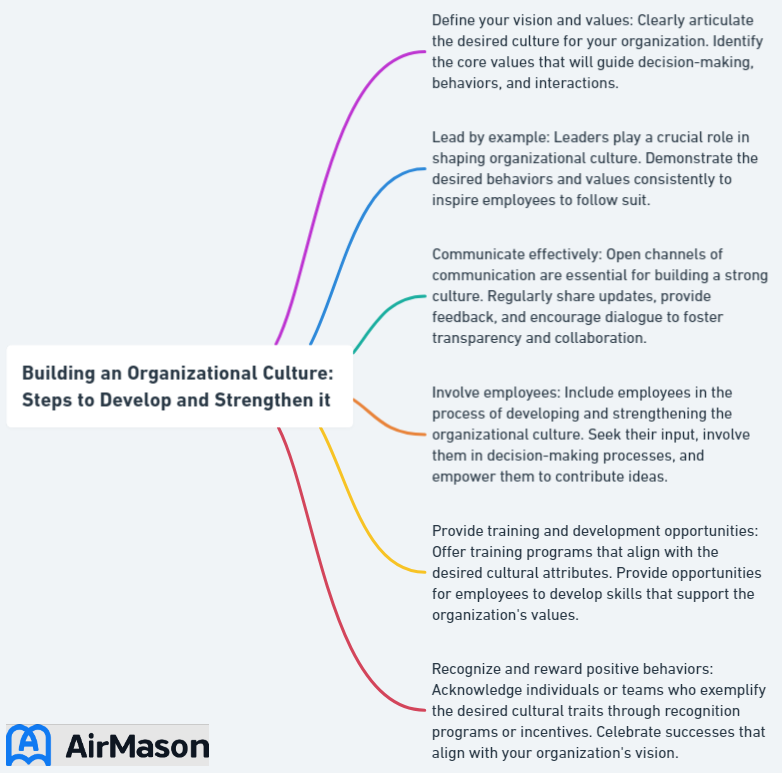
In today’s competitive business landscape, a strong organizational culture is a key component for success. It shapes employee behaviors, fosters innovation, and enhances overall performance. This blog post will guide you through the process of building an organizational culture, ultimately leading to a more engaged and high-performing workforce.
Key Takeaways
- Understand the influence of leadership on organizational culture and its impact on the work environment.
- Define core values, conduct a cultural audit & analyze employee feedback to assess current culture.
- Strengthen your organizational culture by promoting engagement, collaboration & well-being. Measure KPIs for progress.
Understanding Organizational Culture
Organizational culture, also known as an organization’s culture, encompasses the shared values, beliefs, and norms that influence the behaviors of individuals and teams within an organization, contributing to a healthy culture.
Grasping the different types of organizational culture, along with the role of leadership in molding it, is key to fostering a thriving workplace environment.

Defining Organizational Culture
Organizational culture, often referred to as corporate culture, is the collective set of behaviors, values, and beliefs shared by the members of an organization, characterized by the practical implementation of norms, best practices, ideals, and shared values. It significantly impacts the success of a business and the atmosphere of the workplace. A beneficial company culture encourages employee engagement, dedication, and enthusiasm in the workplace, from the newest hires to the executive team. Understanding and fostering a company’s culture is essential for maintaining a positive and productive workplace culture.
Delineating a company’s values is critical as they serve as the basis of a company’s culture. An initial investment of time in determining the most suitable culture for your organization helps in building a positive company culture, rather than trying to fix it later on. Culture cannot be formed solely through press releases or policy documents. It is indeed created by consistent and authentic behaviours. Employees contribute to company culture by imparting their individual experiences and values.
An Organization’s Culture
An organization’s culture encompasses the shared values, beliefs, and practices that define its identity and shape the behavior of its members. It serves as the foundation upon which the company operates, influencing everything from decision-making processes to employee interactions. An organization’s culture is often considered its unique fingerprint, distinguishing it from others in the same industry. It sets the tone for how employees engage with their work, colleagues, and external stakeholders, ultimately influencing the overall success and sustainability of the organization. A healthy and positive organizational culture can lead to increased productivity, employee satisfaction, and innovation, while a toxic or misaligned culture can have detrimental effects on morale and performance. Therefore, understanding, nurturing, and aligning an organization’s culture with its mission and goals is of paramount importance in fostering a thriving and successful enterprise.
Types of Organizational Culture
There are various types of organizational culture, such as:
- Hierarchy culture: emphasizes structure and control
- Market culture: emphasizes results and competitiveness
- Clan culture: fosters collaboration and family-like connections among employees
- Adhocracy culture: focuses on innovation and adaptability
- Network culture: emphasizes collaboration and connections across different organizations
Each type has its unique characteristics and impact on the organization.
A thorough comprehension of the various types of organizational culture aids in choosing one that aligns with your organization’s mission, vision, and objectives. It is essential to choose a culture that supports employee engagement, teamwork, and productivity, ultimately contributing to the organization’s success.
The Role of Leadership in Shaping Culture
Leadership plays a crucial role in forming and sustaining a robust organizational culture. When employees observe leaders embodying the organizational culture, they are more likely to emulate their example. Leaders set the tone, communicate the vision, and model the values that are necessary for achieving the strategic objectives of the business.
To prioritize organizational culture, leaders can:
- Engage in dialogue surrounding the organization’s culture and values
- Factor in employee feedback when formulating cultural advocacy strategies
- Demonstrate effective leadership and decision-making to create a strong organizational culture that supports employee engagement, productivity, and business success.
Assessing Your Current Culture

Before you start developing and reinforcing your organizational culture, it’s important to evaluate where it currently stands. This can be done through conducting a cultural audit, identifying core values, and analyzing employee feedback.
By evaluating your existing culture, you can identify areas for improvement and create an actionable plan to enhance employee engagement and overall organizational performance.
Conducting a Cultural Audit
A cultural audit is a comprehensive assessment of an organization’s values, work environment, policies, practices, and employee behaviors. The process involves:
- Identifying cultural levers
- Determining the audit’s goal
- Creating a team, timeline, and budget
- Choosing methods and tools such as surveys and interviews
- Analyzing and interpreting the data collected
- Reporting and acting on the findings to address any disparities between the desired culture and the existing culture.
The engagement of key stakeholders, including:
- Leadership
- Human resources
- Employees
- External consultants
Plays a significant role in the successful execution of a cultural audit. A thorough audit uncovers the strengths and weaknesses of your current organizational culture, providing insights into the areas that need improvement and the aspects that are already working well. This information can be used to create a roadmap for developing a strong organizational culture.
Identifying Core Values
Recognizing core values is essential in forming organizational culture, as they characterize a company’s identity, enhance recruitment and retention, affect behavior, assist in decision-making processes, and form organizational culture.
Identifying your organization’s core values involves:
- Gathering input from team members
- Analyzing past successes and failures
- Reflecting on the organization’s mission and vision
- Conducting surveys or interviews
- Consolidating and prioritizing
- Communicating and integrating these values throughout the organization.
Core values are the guiding principles that shape the way your organization operates and interacts with its stakeholders. They help to create a strong foundation for your organizational culture and provide a clear direction for employees, enabling them to make decisions and take actions that align with your company’s overall goals and vision.
Analyzing Employee Feedback
Employee feedback is a crucial aspect of assessing your organizational culture. It provides insights into employees’ perceptions, experiences, and opinions regarding the work environment, leadership, policies, and practices. Analyzing survey results can assist in recognizing common trends in employee feedback and valid areas of concern.
Employers can facilitate honest feedback from employees by providing avenues for anonymous surveys, enabling them to express themselves freely. Tools such as:
- Qualtrics
- ContactMonkey
- 15Five
- Officevibe
- TINYpulse
- Trakstar
can be utilized to gather and analyze employee feedback. By listening to employees’ experiences and concerns, organizations can better understand their current culture, identify areas for improvement, and make informed decisions to enhance their workplace environment and overall organizational culture.
Work for Curated
If you’re seeking opportunities to work for curated platforms, you’re in luck. Many companies today recognize the value of curated content and the impact it can have on their brand. Working for a curated platform often means contributing your expertise to sift through a vast array of information or products, selecting the best, and presenting them in a way that is meaningful and valuable to the audience. This could involve anything from curating art collections for a gallery to selecting products for an e-commerce website. The role demands a keen eye for detail, a deep understanding of the target audience, and the ability to discern quality from mediocrity. Moreover, working for curated platforms can be a rewarding experience, as it allows you to play a pivotal role in shaping the narrative and offerings of a brand or platform.
Developing a Strong Organizational Culture

After evaluating your current organizational culture, the next step is to enhance and reinforce it. This can be achieved by establishing a clear vision and mission, aligning culture with business strategy, and fostering open communication.
By focusing on these critical components, you will create a strong organizational culture that supports employee engagement, productivity, and overall business success.
Establishing Clear Vision and Mission
A clear vision and mission statement provide direction and purpose to your organization. They serve as the foundation for your organizational culture and guide your employees in understanding the company’s goals and the role they play in achieving them. A well-defined vision and mission inspire employees and foster a sense of unity and commitment toward the organization’s objectives.
The effective communication of your vision and mission to all employees is a vital step in developing a robust organizational culture. This includes:
- Incorporating them into your hiring and onboarding processes
- Integrating them into your daily operations
- Reinforcing them through regular communication and employee recognition
By consistently emphasizing your organization’s vision and mission, you create a strong foundation for your organizational culture.
Aligning Culture with Business Strategy
The alignment of organizational culture with business strategy is crucial to achieve your company’s goals and optimize success. When your culture supports your strategic goals, employees are more likely to be engaged, committed, and focused on achieving those goals. For example, a culture of innovation would be in harmony with a business strategy that emphasizes cutting-edge products and services.
To align your organizational culture with your business strategy, consider the following steps:
- Bring company values to every meeting and task.
- Ensure that strategic business goals and cultural values and behaviors are mutually supportive.
- Make effective communication a key goal and align values with vision.
- Define who the culture carriers are and involve them in aligning culture with strategy.
- Recognize and support the desired behavior of the organization.
- Involve employees in the process to identify areas of disconnect and address them.
By aligning culture with strategy, you create a positive culture that is harmonious and goal-oriented, fostering success in the workplace.
Fostering Open Communication
Open communication is vital for establishing a healthy organizational culture. It facilitates trust and understanding between employees, promotes collaboration and innovation, and enables more effective problem-solving and decision-making. Encouraging open communication throughout your organization ensures that employees feel engaged, valued, and supported in their work environment.
To foster open communication, consider implementing policies and practices that encourage dialogue between team members, such as an open-door policy, team-building activities, and regular feedback sessions. Additionally, utilizing digital solutions and virtual communication tools can break down hierarchical barriers, improve transparency, and promote a more inclusive and connected work environment. By prioritizing open communication, you create a positive work environment where employees feel engaged and empowered to contribute to the organization’s success.
Strengthening Your Organizational Culture

After establishing a robust organizational culture, it’s important to continually fortify and uphold it. This involves promoting employee engagement, encouraging collaboration and teamwork, and prioritizing employee well-being, all of which contribute to a good company culture.
By focusing on these aspects, you will create a resilient and high-performing organizational culture that drives business success.
Promoting Employee Engagement
Employee engagement is key in bolstering organizational culture and nurturing a sense of belonging and commitment within the organization. Engaged employees are more productive, innovative, and committed to their work, which ultimately contributes to the overall success of the organization. To promote employee engagement, companies should:
- Prioritize inclusion during the onboarding process
- Ensure employees have access to necessary materials and time resources
- Regularly conduct employee engagement surveys to monitor progress
Conducting an employee engagement survey provides insights into particular areas of dissatisfaction and potential areas for improvement. By addressing these concerns and implementing initiatives that support employee engagement, organizations can create a more pleasant work atmosphere, enhance employee satisfaction, and drive business success.
Encouraging Collaboration and Teamwork
Collaboration and teamwork are essential components of a strong organizational culture. They facilitate:
- Communication
- Innovation
- Productivity
- Improved problem-solving and decision-making
By working together towards a common goal, employees can exchange ideas, knowledge, and skills, resulting in a more effective and cohesive team.
To promote collaboration and teamwork, organizations can establish clear objectives and expectations, offer resources and assistance, encourage open dialogue, acknowledge and reward team efforts, and cultivate an atmosphere of trust and respect. Implementing team-building exercises and activities can also help forge connections between team members, improve communication, and foster a sense of belonging, ultimately contributing to a stronger organizational culture.
Prioritizing Employee Well-being
Prioritizing employee well-being is an essential aspect of fostering a strong organizational culture. When employees feel valued and supported, they are more likely to be engaged, productive, and committed to the organization. By focusing on employee well-being, organizations can create a positive and inclusive culture that aligns with their values and drives business success.
Strategies for emphasizing employee well-being may include offering mental health assistance, implementing flexible work schedules, and acknowledging employees’ efforts. By prioritizing the well-being of employees and promoting work life balance, organizations not only create a more supportive and inclusive work environment but also contribute to the overall success and resilience of the company.
Article on Company Culture: Fostering a Positive Work Environment
Crafting an insightful article on company culture involves delving into the intricacies that define a thriving work environment. A well-articulated piece on company culture not only sheds light on the values, beliefs, and practices that shape a workplace but also emphasizes their impact on employee satisfaction and productivity. This article will explore the significance of a strong company culture in attracting and retaining top talent, ultimately influencing the overall success of an organization. By examining real-world examples and best practices, readers will gain a comprehensive understanding of how to cultivate a positive and inclusive work culture that resonates with employees at every level. Moreover, it will delve into the role of leadership in championing these values and creating an atmosphere of trust and collaboration. Through practical insights and actionable strategies, this article aims to equip businesses with the knowledge and tools necessary to cultivate a company culture that empowers both the organization and its workforce.
Measuring the Impact of Organizational Culture

Measuring the impact of your organizational culture initiatives through key performance indicators (KPIs) and frequent assessments is crucial for ensuring their effectiveness. By monitoring these metrics, organizations can:
- Evaluate the alignment between their culture and desired outcomes
- Pinpoint areas for improvement
- Make data-driven decisions to reinforce their organizational culture.
Key Performance Indicators (KPIs)

KPIs are quantifiable values that monitor and evaluate the efficacy of an organization’s culture initiatives. Examples of such KPIs include:
- Turnover rate
- Rates of absenteeism
- Internal promotions
- Referrals
- Employee net promoter score (eNPS)
These indicators yield insights into the effect of organizational culture on employee performance and engagement.
To select the appropriate KPIs for your organization’s culture, consider the following steps:
- Identify the desired cultural attributes and behaviors.
- Align KPIs with cultural goals.
- Consider the Balanced Scorecard approach.
- Measure critical issues.
- Align KPIs with business objectives.
By monitoring these KPIs, organizations can evaluate the alignment between their culture and desired outcomes, pinpoint areas for improvement, and make data-driven decisions to reinforce their organizational culture.
Regularly Assessing and Adjusting
Regular appraisal and adjustment of organizational culture prove beneficial as they allow organizations to pinpoint areas for growth and implement the necessary changes to ensure continuous progress. Organizations can assess their organizational culture through conducting a cultural audit, determining core values, and examining employee feedback. To adjust their organizational culture, organizations can create a clear vision and mission, align culture with business strategy, and promote open communication.
By regularly assessing and adjusting your organizational culture, you ensure that it remains in line with your goals and objectives. This continuous improvement process allows your organization to adapt to changing circumstances, maintain a strong and resilient culture, and drive ongoing success in the ever-evolving business landscape.
Summary
Developing and strengthening a strong organizational culture is essential for the success of any organization. By understanding the various types of culture, assessing your current culture, and implementing strategies for improvement, you can create a positive, engaging, and high-performing workplace that supports your organization’s goals and objectives. Prioritizing employee engagement, collaboration, well-being, and regular assessments ensures continuous improvement and resilience in the face of challenges, ultimately driving business success.
Frequently Asked Questions
How do you build an organizational culture?
Build a strong organizational culture by defining shared values, investing in diversity and belonging programs, creating positive employee experiences, providing clarity to reduce silos, recognizing employee accomplishments, and equipping employees for success.
What are the four 4 major elements of organizational culture?
Organizational culture is comprised of four major elements: Recognition, Values, Employee Voice and Leadership, as well as a feeling of Belonging. All of these are essential components of creating a great company culture.
What are the 4 steps used to create a culture in an organization?
Four steps used to create a company culture are defining values, setting goals, asking team members what they want to see in the culture, and developing a plan to bring the culture into daily work.
What is the significance of leadership in forming organizational culture?
Leadership plays an integral role in setting the tone and modeling the values of an organization, which are vital for achieving its strategic objectives.
How can organizations assess their current organizational culture?
Organizations can assess their current culture by conducting a cultural audit, determining core values, and examining employee feedback to gain insight into what works and where changes may be needed.